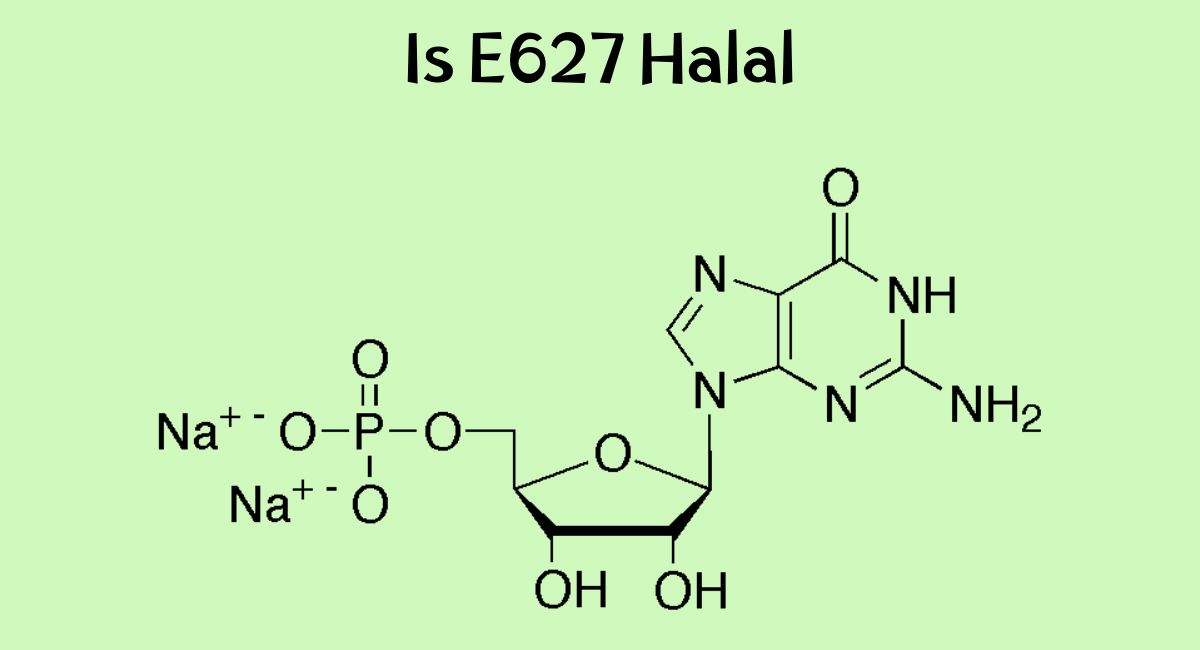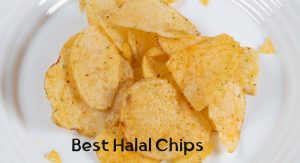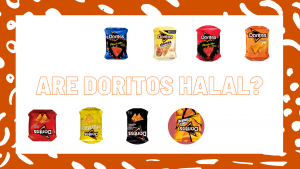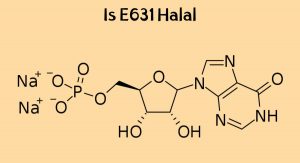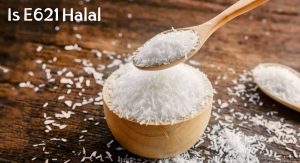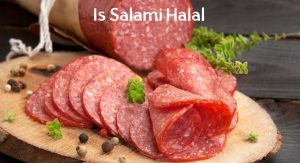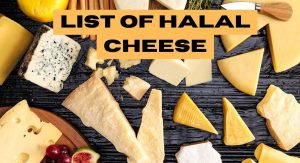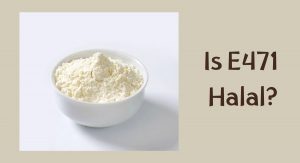In a world where the demand for halal-certified products is on the rise, consumers are becoming more conscious about the ingredients in the food they consume.
One ingredient that has sparked controversy and confusion is E627, also known as disodium guanylate.
This food additive is commonly used in processed foods to enhance flavors, but its halal status has been a topic of debate among Muslim communities.
In this article, we will explore the origin of E627, its role in the food industry, and delve into the question of whether E627 can be considered halal or not.
Is E627 Halal
Disodium guanylate is produced from guanosine monophosphate, which can be derived from various sources. This is where the question of whether it is halal comes in.
Most of the time, E627 is derived from yeast extract or sardines and is completely halal. But, in some instances, it can be derived from pork or other non-halal animal sources, which would make it haram, or forbidden under Islamic dietary laws.
However, if the source of E627 is not specified on the food label, you might want to contact the manufacturer directly for clarification or avoid consuming that product if you strictly adhere to a Halal diet.
What is E627
E627, also known as disodium guanylate, is a food additive and flavor enhancer that is commonly used in the food industry. It is often used in conjunction with another flavor enhancer called monosodium glutamate (MSG) to enhance the savory or umami taste of foods. E627 is a sodium salt of guanylic acid, which is a naturally occurring compound found in various foods, including mushrooms and some meats.
This additive is known for its ability to boost the overall flavor of food products by intensifying the existing savory flavors. It is commonly found in processed foods such as instant noodles, soups, sauces, snacks, and some processed meat products.
E627, also known as disodium guanylate, is a flavor enhancer that is commonly used in conjunction with monosodium glutamate (MSG) and/or disodium inosinate (E631) to enhance the umami taste of foods. It is often used in processed foods like soups, snacks, and canned foods.
Sources of E627
E627 can be derived from various sources:
- Fish: Certain types of fish, particularly sardines and bonito, are rich sources of guanylates, the group of flavour-enhancing nucleotides in which E627 falls. The fish are harvested, their flesh extracted, and then refined to extract the guanylates. This is often further refined into the disodium salt form, E627, to be used in food production.
- Seaweed: Certain types of seaweed, particularly from East Asian waters, are harvested for their guanylate content as well. Kombu, a type of kelp popular in Japanese cuisine, is one such seaweed which is a rich source.
- Yeast Extracts: Yeast extracts are another source. They are the common byproducts of the beer-brewing process, as yeast is used to ferment the sugars in the brewing mixture. The yeast residue is processed and refined to extract useful compounds, including E627.
- Mushrooms: Certain types of mushrooms, such as shiitake, are a rich natural source of guanylates, too. The mushrooms are dried and then ground up to make an extract which is rich in E627.
- Meat and Dairy: Certain types of meat and dairy products are also sources of E627, though this is less common due to the cost associated with extraction. Animal foods contain a substance called guanosine monophosphate (GMP) – the compound that, when combined with sodium, forms disodium guanylate. Foods with high concentrations of GMP include meat (such as beef, chicken, and pork), fish, and dairy products like cheese and milk, which is why these foods are often rich and savory.
- Synthetic Production: Most E627 used in commercial food production, however, is synthetically produced, as it is cheaper and more efficient than extraction from natural sources. The main synthetic production method involves fermentation using a strain of bacteria, typically Bacillus subtilis. They are grown in vats, where they are fed with carbon and nitrogen sources, and they produce guanosine, which is then converted into E627.
How is E627 Made
Synthetic Methods
E627, or disodium guanylate, is often produced synthetically because it’s a more cost-effective and efficient process than extraction from natural sources. Here’s a general overview of how this process occurs:
- Selection of Bacteria: The process typically starts by selecting a strain of bacteria that naturally produces guanylates. This is typically a strain of bacteria called Bacillus subtilis.
- Fermentation Process: These bacteria are then placed in a nutrient-rich environment where they can thrive and reproduce. The bacteria are fermented in large vats, which may contain carbon and nitrogen sources like glucose or ammonium, and are kept at a controlled temperature and pH level. The bacteria feed on these nutrients and produce guanosine through their metabolism.
- Extraction of Guanosine: Once the fermentation process finishes, the resulting mixture is processed to extract the guanosine.
- Conversion to Disodium Guanylate: The guanosine is then converted to its disodium salt form, E627. This is done by neutralizing guanosine monophosphate with sodium hydroxide or sodium carbonate, which yields a product with two sodium ions — hence the name ‘disodium guanylate’.
- Purification: Finally, the disodium guanylate is refined and purified for use in food production.
- Testing: Before being distributed for use in the food industry, the E627 would be rigorously tested to ensure it meets food safety and quality standards.
Natural Sources
While E627 is typically synthetically created for use in the food industry due to cost and efficiency, it can also be derived from natural sources. It’s found in many animals and plants, but is particularly plentiful in fish like sardines and bonito, as well as in some types of seaweed and mushrooms.
- Fish: Specifically, sardines and bonito are considered good sources. The fish are caught and their flesh is extracted. They are then boiled to create a fish soup, which is then reduced over a period of several hours. The resulting product is a fish extract rich in disodium inosinate and disodium guanylate, including E627.
- Seaweed: Some types of seaweed, especially kombu, are often used. The seaweed is harvested, sun-dried, and then boiled to make a seaweed broth. The broth is then simmered until the water is nearly gone and a paste remains. This paste is rich in disodium inosinate and disodium guanylate, among other flavor compounds.
- Mushrooms: Certain types of mushrooms, such as shiitake, are a natural source of GMP which is the building block for E627. Dried shiitake mushrooms can be boiled in water to create a rich, flavorful broth. This broth can then be reduced to a paste or a concentrated liquid, which can be used as a flavor enhancer in foods.
Each of these processes would need to be followed by further stages of refinement and purification to isolate E627. With that being said, extraction of E627 from such natural sources for commercial use isn’t common as it’s less economical and yields lesser amount of E627 as compared to yeast fermentation or synthetic methods.
Uses of E627
E627 is often used in conjunction with another flavor enhancer called disodium inosinate (E631) to create a synergistic effect known as umami, which is the fifth basic taste sensation alongside sweet, sour, bitter, and salty. Here are some common uses of E627 in the food industry:
- Processed Foods: E627 is frequently added to processed foods like snacks, instant noodles, canned soups, and frozen meals to enhance their savory and umami flavors.
- Sauces and Seasonings: It is used in various sauces and seasonings, such as gravies, salad dressings, barbecue sauces, and spice blends, to improve the overall taste.
- Packaged Soups and Broths: Many packaged soups and broths contain E627 to boost the flavor and make them taste more savory and satisfying.
- Snack Foods: E627 can be found in a wide range of snack foods, including potato chips, crackers, and pretzels, to make them more flavorful.
- Instant Noodles: Instant noodles, which are a staple in many cultures, often contain E627 to enhance their taste and make them more appealing.
- Bouillon Cubes and Powder: It is used in the production of bouillon cubes and powder, which are used as a base for soups and stews.
- Processed Meats: Some processed meats like sausages and canned meats may contain E627 to improve their flavor.
- Flavor Enhancers: E627 is often used in combination with E631 (disodium inosinate) and E621 (monosodium glutamate or MSG) to create a more robust umami flavor.
Is E627 Safe to Eat
E627 is generally recognized as safe (GRAS) for consumption by regulatory authorities, including the U.S. Food and Drug Administration (FDA) and the European Food Safety Authority (EFSA), when used in accordance with established guidelines and within specified limits. It is considered a safe food additive when used in processed and packaged foods to enhance flavor.
However, like many food additives, some individuals may have sensitivities or allergies to E627, just as they might with other food additives. Additionally, some people may choose to avoid certain food additives for dietary or personal reasons.
If you have concerns about E627 or other food additives, you can:
- Read Food Labels: Check the ingredient labels on packaged foods to see if E627 is listed. This can help you make informed choices about the foods you consume.
- Consult a Healthcare Professional: If you have specific health concerns or dietary restrictions, it’s a good idea to consult with a healthcare professional or a registered dietitian who can provide personalized guidance based on your individual needs.
- Limit Processed Foods: One way to reduce your intake of food additives, including E627, is to consume fewer processed and packaged foods. Preparing meals from fresh, whole ingredients at home can help you have more control over what you eat.
For further insights into the halal status of various food additives, explore our comprehensive resources. Stay informed about what’s permissible and what’s not in Islamic dietary practices.
Is Vanilla Extract Halal or Haram: Discover the halal status of vanilla extract in this insightful article. Uncover whether this beloved flavoring agent aligns with Islamic dietary guidelines.
Is E621 Halal or Haram: Dive into the world of food additives with a focus on E621 in this article. Find out if this common ingredient, also known as MSG, is considered halal or haram.
Is E631 Halal or Haram: Explore the halal perspective on E631, often used in processed foods. Learn whether this food additive, derived from animals, complies with Islamic dietary regulations.
Are Enzymes Halal in Islam: Get the facts about enzymes and their halal status in this informative article. Learn whether these essential food processing agents are permissible under Islamic dietary principles.
Is E471 Halal in Islam: Discover the truth about E471, a common food additive, and its halal status. Dive into the world of food ingredients to understand whether E471 meets halal dietary requirements.
